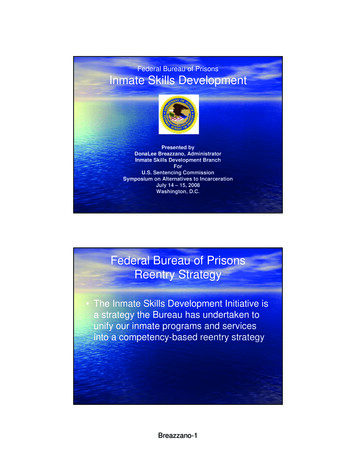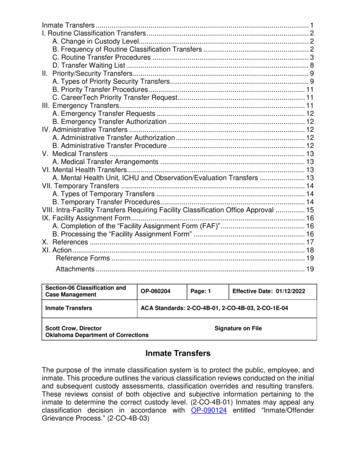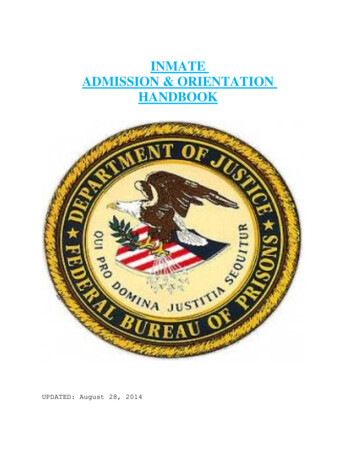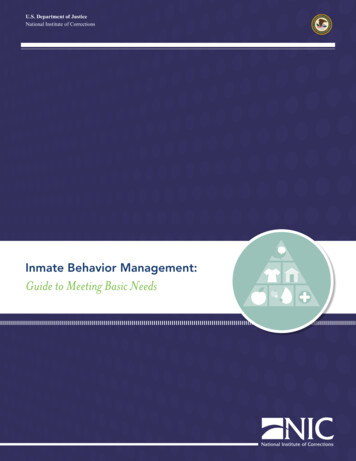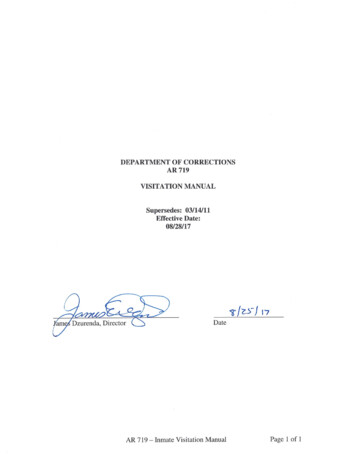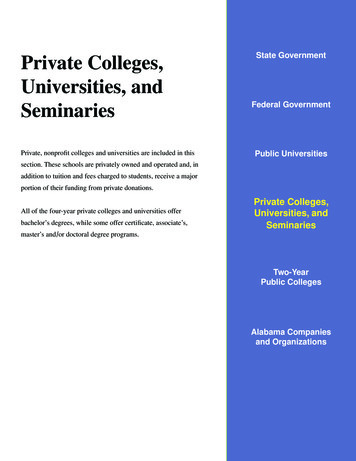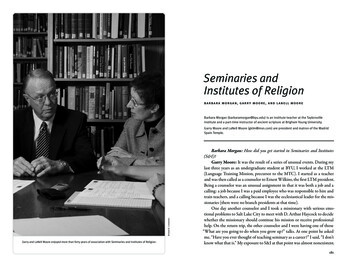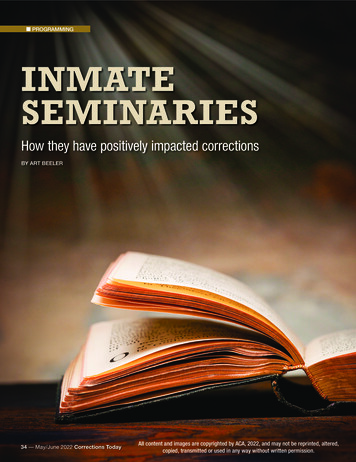
Transcription
n PROGRAMMINGINMATESEMINARIESHow they have positively impacted correctionsBY ART BEELER34 — May/June 2022 Corrections TodayAll content and images are copyrighted by ACA, 2022, and may not be reprinted, altered,copied, transmitted or used in any way without written permission.
Inmate Seminaries found their way in thecorrectional lexicon in 1995, after the ViolentCrime Control and Law Enforcement Actof 1994 eliminated Pell Grants for offenders forpost-secondary education.Although there was a graduate program in religious programming at Sing-Sing in New York, the realcredit for the development of inmate seminaries in theUnited States belongs to Burl Cain, Commissioner,Mississippi Department of Corrections and then Warden at the Louisiana State Penitentiary (Angola).In 1994 he entered into discussion with the leadership at the New Orleans Theological Seminary, todetermine if there were ways to develop a seminaryat Angola. There are prison seminaries in about 14states at this time including one at the Nash Correctional Institution in North Carolina. This analysisprimarily reviews the Angola Prison Seminary andthe Darrington Prison Seminary in Texas.As with many program initiatives, this effort toincrease educational opportunities has led to othervictories. The most significant has demonstratedreductions of inmate violence and inmate misconduct. While recidivism was generally reduced, thesefindings were not as robust.North Carolina initiated a prison seminary withthe Southeastern Baptist Theological Seminary atthe Nash Correctional Institution, with its first classstarting in August 2017. Of the first 24 students whoobtained their degree in December 2021, 17 weredeployed as field ministers to some of the 55 institutions within the North Carolina Division of Prisons.Seven of the graduates remained at Nash to assistwith the program.The seminary program has offered classes everyAugust since 2017 with average classes consisting of30 offenders. At any given time, there are about 120offenders studying to obtain their degrees.As Joe Gibbs, a significant contributor to the program has said, if you are going to be successful youneed a plan. He has attempted through his interactions with the program to impart to the students theneed to have a game plan for life (2009). WardenDrew Stanley and his staff at Nash have been champions for the seminary.The reason for this is clear: Most inmate programs are measured against recidivism and look atoffenders who have a short period of time remaining to serve. The inmate seminary programs aregeared toward moral recognition and tend to look atPhoto courtesy Burl CainAlthough there was a graduate programin religious programming at Sing-Singin New York, the real credit for thedevelopment of inmate seminaries inthe United States belongs to Burl Cain,Commissioner, Mississippi Departmentof Corrections and then Warden at theLouisiana State Penitentiary (Angola).Burl Cain, Commissioner, MississippiDepartment of Corrections.Background photo: istock/dlerickCorrections Today May/June 2022 — 35
n PROGRAMMINGoffenders who are longer term offenders preparing forthe rest of their lives. While the data does demonstratesome success in recidivism reduction, it must be clearinmate seminaries are measuring factors other than successful reentry and recidivism.Respondents also reported thethree most important factorsin connecting to the prisoncommunity to be: helping others,growth and positivity.This is seen in the work field ministers accomplishsubsequent to graduation. They fall into four categories:1) Community Services Ministries includes orientationof new arrivals to the institution, mentoring, personalimprovement and academic tutoring; 2) Crisis Ministry includes conduct of funeral and memorial services,geriatric care, grief counseling and medical and hospicevisitation; 3) Counseling Ministry includes family reconciliation, offenders forgiveness programs, tier talking,visiting with those unable to participate in program orchaplaincy services; and, 4) Faith-based ministry whichunder supervision provides discipleship courses, inmate preaching and planning and conducting of services(Jang, S., Johnson, B., Hays, J., Hallett, M., and Duwe,G., 2019). The authors use Sutherland’s DifferentialAssociation Theory as well as Cressey’s theory of therehabilitative value of ex-prisoners being placed intotrusted positions associated with positive role definitionwhich some call pro social activities. Executive Directorof Texas Division of Criminal Justice, Bryan Collier saysthese factors are important because the offenders who gothrough seminary programs and become field ministershave credibility.A long-term analysis of the Texas programs implies itreduces dissatisfaction with correctional staff, which mayenhance prison security by reducing the ‘strain’ betweenlegitimate goals and lack of opportunities to achieve those36 — May/June 2022 Corrections Todaygoals. [Merton’s Strain Theory] (Giddens and Sutton(2017). The analysis also demonstrates a positive relationship to an inmate’s sense of meaning and purpose. Theprogram allows Field Ministers the ability to see the bigpicture and help those involved in possible errant behaviors see the larger issue thus reducing misconduct andperhaps violence, and finally, Field Ministers have theability to give back to society (Jang, Johnson, Hays, Hallett and Duwe, 2019).Benefits of inmate seminariesfor facilitiesIt is important to look at the desire of long-term inmatesto participate in programs. It is also important long-terminmates are looking not so much for recreational or educational programs but in programs which can provide themresources, self-dignity and worth (Louviere, Spring 2017).Louviere concludes forming connections with fellowprisoners in a positive manner is beneficial to inmate healthand safety in the prison environment. Correctional administrators try to keep violence at a minimum. Typically, safetyis equated to physical security and keeping offenders busy(Fleury-Steiner, 2015; Mears & Castro, 2006). The cost ofkeeping the public safe in this manner increases because ofthe health care needs of offenders and the need for space tohouse these existing offenders.There is a gap in the literature concerning what longterm offenders see as their programming needs. The datashows that at the Louisiana State Penitentiary, long-terminmate’s most important activity was educational programs, religious programs and prison jobs in that order.Other surveys were done subsequently, with the most telling point being religious programming was always in thetop three (Louviere, 20177).Respondents also reported the three most importantfactors in connecting to the prison community to be: helping others, growth and positivity. Louviere’s work wasnot directed exclusively to seminary programs, but to theimpact of program participation on interpersonal inmateconnections.An article on U.S. Prison Seminaries: Structural Charity, Religious Establishment, and Neoliberal Connections(2019), emphasized the need for any seminary programto acknowledge the need for certain factors to keep theestablishment clause of the Constitution from being
invoked. The complexities of religious establishment inU.S. prisons means administrators need to understand thenuances of First Amendment practice balanced against thesecurity of the institution. Administrators must determinehow best to allow intermediaries entrance to prisons andguard against one religion having preference over another(Hallett, M., Johnson, B., Hays, J., Jang, S., and Duwe,G., (2017).Legislative and regulatory bodies considering seminary programs must: Create statutes or regulations whichhas a secular purpose; the principle or primary effect ofthe statutes or regulations must not advance nor inhibitreligious practice; the statutes or regulations must notresult in an excessive government entanglement withreligious affairs.As long as these factors are followed and the cost ofthe programs are not paid by the state there have been nosuccessful legal challenges to seminary programs. Thepurpose of the seminary program is to provide highereducation programs to an offender population and targetslong-term offenders because of program requirements tocomplete course work and field ministries. Since theseprograms were initiated subsequent to the abolition ofPell Grants, any reinitiating of Pell Grants for post-secondary education will need to be reviewed.A 2015 article on Bible College Participation andPrison Misconduct: A Preliminary Analysis, lookedprimarily at the Darrington Bible College, an in-houseprison seminary located at the Darrington CorrectionalInstitution in collaboration with Southwestern Theological Seminary. The authors of this study used aretrospective quasi-experimental design to determine theaffect the Bible College had on disciplinary infractions.The dependent variable in the study is prison misconduct resulting in a discipline conviction that occurredafter the time of enrollment in the Bible College. Independent variables included age, race, marital status,education, gang membership, custody level, criminalhistory, discipline history and institutional programinvolvement. The other independent variables includedwere inmate classification, time served, admission type,offense type and type of sentence (Duwe, G., Hatlett,M., Hays, J., Jang, S., and Johnson, B., 2015). Aftermatching the populations of the Bible College population with a comparison group, the following resultswere found:Type of discipline convictionBible CollegeComparisonAny minor discipline19.1%47.0%Total minor discipline.27.90Any major discipline6.1%27.8%Total major discipline.08.43Any discipline23.3%56.5%Total discipline.351.32It is noted the total discipline convictions over thelength of the study was nearly four times greater for thecomparison group than the Bible College group. Thefindings demonstrated that participating in the BibleCollege significantly improved behavior. The risk ofmisconduct was lowered by 65-80% and the total numberof discipline convictions reduced by more than one perparticipant (Duwe, G., Hatlett, M., Jang, S., and Johnson,B., 2015).Teaching positive criminologyInmate seminaries, in addition to the spiritual workthey teach, apply positive criminology to the developmentof curriculum and the teaching the students. Accordingto Sutton, (2022), positive criminology is an approachto crime prevention involving intervention programs toreduce criminal behavior. Traditional criminology identifies some of the causes of deviant behavior, but generallyfails to recognize how offenders can avoid or stop thisbehavior (Sutton, 2022). It is clear positive criminology isessential to understanding deviant behavior, but it is alsoclear it is more than a single theory. It is a broad perspective toward behavior encompassing diverse roles andaims to distance the individual from behavior associatedwith crime through therapy programs and interventionsdesigned to build upon the strengths of a person’s development, emphasis on positive social elements such asprograms of prosocial behavior, social acceptance, human kindness and reintegration and developing positivepersonal factors such as resilience, positive emotions andmorality (Ronel and Elisha, 2011). Corrections Today May/June 2022— 37
n PROGRAMMINGThe following components may not be all inclusivebut presents positive criminology components.positive interpretation of stressful events and can helpfacilitate transformative change.Factors of protection and resilienceExposure to goodnessResilience is necessary to help individuals cope withrisk and stress and recover from damaging environments.It requires a combination of emotional hardiness, positiveadjustment and significant social, family and personalprotective factors (Kobassa, 1982).By being exposed to positive human values, positivecriminality can assist at-risk individuals from choosing acriminal lifestyle. This exposure to goodness also allowsindividuals to grow and develop the skills to “do well,”without expecting anything in return. Many people at-riskfind by developing skills typically through volunteeringthey become better at making positive life choices.Growth out of traumaTrauma can damage relationships, values and beliefsand occasionally lead to unacceptable social behaviors.Growth out of trauma emphasizes the development ofskills and personal resources to develop post-traumaticgrowth and can lead to identifying new meanings in life.The growth out of trauma component supports salutogenic theory, where positive and negative experiences giveshape and provide coherence (Antonovsky, 1987).Interpretation of risk factorsAll of us differ in how we experience risk factors suchas abuse, poor parenting, failing schools where individuals may ascribe negative aspects of their lives. Positivecriminology takes these risk factors and develops aSocial acceptanceClassical criminology focuses on negatives, wherepositive criminology focuses on the benefits of socialacceptance. Replacing exclusion with inclusion can haveimpactful results. Those released from prison are notviewed as morally disgraced which enhances successfulreintegration into the community and reinforces ongoingbehavioral change.Desistance from crimeResearch has demonstrated the successful transitionof returning citizens is not one single jump but a seriesof smaller steps leading to stopping criminal activities.Along the way, these returning citizenswork to rebuild their lives from a negativeto positive orientation helping to successfully integrate into their communities.Criminology as peacemakingPositive criminology replaces thepunishment model of law enforcementwith one of compassion while at the sametime understanding public safety. It aims toreduce violent crime by developing calmand peaceful methodologies of changingbehaviors.Restorative justiceistock/apomaresPositive criminology emphasizes theperpetrator of a crime take ownership forwhat they have done and the hurt they haveinflicted on victims. Mediation, dialogueand conflict resolution make up parts ofrestorative justice.38 — May/June 2022 Corrections Today
Good Lives ModelThe good lives model originated in the early 2000’s inresponse to developing rehabilitative efforts to deal withsex offenders. This model has expanded to attemptingto rehabilitate all crimes and focuses on an individual’sstrengths while reducing risks (Bonta and Andrews,2011). This is in contrast to the traditional Risk-NeedResponsivity model and its focus on risk management.The Good Lives Model (GLM) is concerned with humandignity and human rights. The individual participant in aGLM program is encouraged to select goals, make plansand act toward their implementation.Yoga and mindfulnessPositive criminology recognizes both yoga andmindfulness have a positive impact upon a prisoners’psychological wellbeing. Low intensity, long-durationprograms have been shown to be more successful thanshorter, low intensity interventions which contribute toimproving prisoner quality of life, prison culture andoutcomes (Auty, Cope and Liebling, 2015).Nonviolent communicationSuccessfully training prisoners in nonviolent communication demonstrate those engaged in these programs areless likely to reoffend, less angry and display increasedfeelings of compassion. It was also found those trainedin nonviolent communication demonstrated a strikingdifference in how they communicated with others versesuntrained inmates (Suarez, et. al., 2014).While there are other components to the GLM, thoselisted above correlate with the positive criminology demonstrated by the inmate seminary program at Angola. Thepower of positive criminology does not come from ignoring the negative but instead recognizing it while focusingon the positives (Sutton, 2022).The rationale of having a discussion regarding positive criminology, is to provide context to a 2015 article onAngola’s seminary entitled: “First Stop Dying”: Angola’sChristian Seminary as Positive Criminology (Hallett,Hayes, Johnson, Jang and Duwe). The four themes whichemerged in this article.1. The importance of respectful treatment of inmatesby correctional administrators,2. The value of building trusting relationshipsfor prosocial modeling and improvedself-perception,3. Repairing harm through intervention, and,4. Spiritual practice as a blueprint of positiveself-identity and social integration amongprisoners.When the warden at Angola attempted to find highereducation programs, it was characterized as the Bloodiest Prison in America. Of the more than 6,300 inmates atthe time of this article, 75% were serving life sentences.The population is disproportionally Black. The relationship between offenders and the administration had beengood and bad. Since 1917, most guards at Angola wereprisoners armed with shotguns. This use of convict guardscontributed to brutality against prisoners. The use ofconvict guards continued until federal intervention in the1960s. At the same time the prison was segregated untilthe 1980s.It is against this historical perspective the inmate seminary program was initiated. Warden Burl Cain wantedto find some program to replace the higher educationprograms terminated as the result of the abolishment ofPell Grants for offenders. He also initiated Unit Management which placed inmates in close proximity to the staffworking with them.In short, the inmate seminary program at Angola grewto embrace holistic positive criminology and provideinmate ministers to internal congregations which:1. Created a new social identity to replace the label ofprisoner or criminal,2. Imbued the experience of imprisonment with purpose and meaning,3. Empowered the largely powerless prisoner by turning him into an agent of God,4. Provided the prisoner with a language and framework for forgiveness, and,5. Allowed a sense of control over an unknown future. Corrections Today May/June 2022— 39
n PROGRAMMINGAngola’s seminary graduates describe the messageof love and service as their blueprint for change and theinmate minister program as an opportunity to demonstratechange in practice (Hallett, Hayes, Johnson, Jang andDuwe , 2015). One of the most comprehensive studiesof Angola’s prison seminary comes from a 2019 thesis,Seminaries in the System: The Effects of Prison Seminaries on Recidivism, Inmate Violence and Costs completedfor the Naval Postgraduate School. Dotson’s (2019)analysis demonstrated prison seminaries are reducingboth recidivism rates and inmate violence.The goal of the seminary program was not to reducerecidivism, but to serve as an option to replace collegeprograms affected by the loss of Pell Grant funding. Theseminary programs do not focus on reentry in the community but rather develop inmate ministers which lookfor graduates to become agents of change. The work todevelop inmate ministers has fostered a successful partnership between the prison, the department of corrections,the seminary and inmates who participate in the program(Dotson, 2019). This partnership has had the added benefit of reducing recidivism and inmate violence.The seminary programsdo not focus on reentryin the community but ratherdevelop inmate ministers whichlook for graduates to becomeagents of change.In the three years before the seminary began, Angolareported 1,346 assaults; in 2015 the number of assaultsdeclined to 343 or a 75% reduction (Golberg, 2015). Theresearch suggests prison seminary programs focusing ontransformation rather than reformation are viable as rehabilitation programs as well.We know recidivism rates are extremely high withup to 75% of offenders nationwide returning within fiveyears. We also know prisons have become increasingly40 — May/June 2022 Corrections Todayviolent, which extends to prison staff as well (Dotson,2019). There are many reasons prison violence is costlybeyond dollars and cents, including the emotional,physical and mental strain on offenders and staff. Prisonseminaries differ from traditional programs which workto keep released inmates from going back to prison. Theylook for graduates to become agents of change in thefacility.Recently, there has been a move to reinitiate somePell Grants. An Evaluation of Seven Second ChanceAct Demonstrations Programs: Impact Findings at30 Months did not reveal a difference in recidivismbetween the program participants and control group(D’Amico and Kim, 2018). More study is needed to determine if reinitiating Pell Grants will provide avenuesfor lower recidivism. Other states started to look atprison seminaries given the reduction in inmate violencedemonstrated at Angola. As indicated, what the programs were after was moral rehabilitation. In Dotson’sstudy, moral people do not rob, steal, and take your caror your life. Moral rehabilitation is the direct result ofspiritual transformation.When reviewing inmate misconduct at Angola, Dotson(2019) found that Bible College inmates were 40% lesslikely to have disciplinary actions than their Non-BibleCollege counterparts.Texas initiated an inmate seminary program at Darrington Penitentiary in 2011. To apply for the Darringtonprogram, inmates had to have 19 years remaining on theirsentence. Inmate ministers in Texas have been sent toseven correction facilities. The TDCJ Executive Directorcites the credibility of the inmate ministers as a factor inmaking positive change among the inmate populationswhere they serve. The first seminary class graduatedfrom Darrington in 2016. There were 224 serious acts ofviolence with a weapon, the next year after the inmateministers had been given assignments, the serious acts ofviolence were zero. A study by Baylor showed participation in the Bible College reduced disciplinary convictionssignificantly, but also reduced reprimands for misbehavior, reducing minor misconduct by 65%, 80% for majormisconduct and 68% for any misconduct.The following graph reveals the reduction in majoracts of violence from 2014-2019. Each of the seven institutions where there were inmate ministers stationed inTexas showed reductions in acts of violence.
Heart of Texas FoundationThis information not only demonstrates a sizablereduction of violence, on the face, it demonstrates a significant change of prison culture.Several other states have inmate seminary programs.The most notable is a program located at Sing-Sing,which partners with New York Theological Seminary,offering a Master of Professional Study degree. It requires applicants to have an undergraduate degree beforeadmittance. This graduate degree teaches students spiritual integration, community accountability and service toothers. After graduating, the inmates serve as peer counselors, chaplain’s assistants or tutors throughout the state.Since 1982 the recidivism rate for participants has beenunder 10%. Since 2014, the recidivism rate has been closeto zero (Markus, 2019).Another prison worth noting is the Calvin Prison inMichigan where a program was started in 2014 after statelegislators visited Angola. In 2014, before the first classstarted there were 853 acts of misconduct; three yearslater there were 257 acts of misconduct or a 70% reduction (Roelofs, 2018).One area not discussed is the Establishment Clause.Historically, opponents of faith-based prison programshave successfully challenged these programs when accompanied by government funding. Prison seminarieswhich have been 100% funded with non-governmentaldonations, have to date withstood the challenge, but thecritics have continued to believe prison seminaries areunconstitutional. In 1971, the LemonTest modified the Establishment Clauseto say it must have a secular purpose,have a predominately secular effectand not foster excessive entanglement.While everyone in the United States,including inmates are free to practicereligion, prisons must demonstrate theyare free from religious preference. InAgostini v. Felton, the standard wasmodified to say the government couldoversee the programs and regulatethem to a certain degree as long as theprograms met the requirements regarding content and intent.While, to date, no prison seminarylitigation has made it to court, therehave been a number of attempts to havestate correctional facilities sever ties with prison seminaries. Generally, challenges have not been attemptedbecause the programs are paid for privately, they are voluntary, and they admit non-Christians (Eckholm, 2013).While no program has been successfully challenged, thisremains something which should be monitored.In conclusion, it is clear prison seminary programsreduce the level of violence and misconduct. In Texas, astudy demonstrated reduction of violence in the institutions where inmate field ministers were stationed. Thedocumented reduction of violence at Angola prison was75%. Similar reductions of violence occurred at otherfacilities. Critics have indicated the reduction of recidivism has not matched the reduction in inmate violenceand misconduct, but the purpose of the inmate seminaryprograms are for moral recognition and not recidivismreduction. While the reduction of recidivism is not theprimary purpose of inmate seminary programs, most demonstrate meaningful reductions.Programs must continue to make sure they meet thetenets of the Establishment Clause. With a reinitiating ofPell Grants those with inmate seminaries need to makesure offenders are free to meet their educational needsthrough that avenue should they desire. However, forthe purpose of reducing institutional violence both at thehome institution where the program is housed and theinstitutions where inmate field ministers are located, aswell as reducing the level of institutional misconduct,Corrections Today May/June 2022— 41
n PROGRAMMINGthe evidence is clear these programs have been moresuccessful than anticipated when in 1995, they wereinitiated as a way to provide higher education to qualified offenders.REFERENCESAgostini v. Felton, 117 S. Ct. 1997 (1997).Andrews, D., Bonta, J, Wormith, J. (2011). “The Risk-Need-Responsivity(RNR) Model: Does Adding the Good Lives Model Contribute toEffective Crime Prevention? Criminal Justice and Behavior.https://doi.org/10.1177/0093854811406356. Retrieved, March 2, 2022.Jang, S., Johnson, B., Hays, J., Hallett, M., Duwe, G. (2019). “PrisonersHelping Prisoners Change: A Study of Inmate Field Ministers within TexasPrisons.” International Journal of Offender Therapy and ComparativeCriminology. 64 (5), 1-28.Kobasa, S. (1982). “The Hardy Personality toward Social Psychology of Stressand Health.” In Sanders and Suls, eds. Social Psychology of Health and Illness,Lawrence Eribawan Associates, Hillside, pp. 1-25.Lavie, N. (2015). “Destructive and Confused, Selective Attention under Load.”Trends in Cognitive Science. 9(2), 75-82.Louviere, E. (2017). Bonds Behind Bars: The Impact of Program Participationon Interpersonal Inmate Connections in Louisiana State Penitentiary, ThesisPresentation at University of Louisiana at Lafayette. Author.Autonovsky, A. (1987). Unraveling the mystery of health. Jossey-BassPublishing, San Francisco.Markus, D. (2019). “What Men in Jail Can Teach About Joy?” Kolbe Times.Author.Auty, K., Cope, A., Liebling, A. (2017). “A systematic review ofmeta-analysis of yoga and mindfulness meditation in prison: Effects onpsychological and well-being and behavioral functioning.” InternationalJournal of Offender Therapy and Comparative 14. Retrieved, March 2, 2022.McDaniel, C., Davis, D., and Neff, S. (2005). “Charitable Choice and PrisonMinistries: Constitutional and Institutional Challenges to Rehabilitatingthe American Penal System, d, March 2, 2022.Camp, S., Daggett, D., Kwon, O., and Klein-Saffran, J. (2008). “The effectof faith program participation on prison misconduct: The Life ConnectionsProgram. Journal of Criminal Justice. Vol. 36, 389-395.Robertson, T. (2008). “The faith-based standard: A review and prospectiveanalysis of Establishment Clause developments in light of Americans Unitedv. Prison Fellowship Ministries.” The University of Toledo Law Review, 39,525-549.Dotson, R. (2019). “Seminaries in the System: The Effects of Prison Seminarieson Recidivism, Inmate Violence and Costs.” Naval Postgraduate School.Washington, DC: Author.Roelofs, T. (2018). “Ionia Warden: Calvin College Program is TransformingMy Prison.” Bridge. son.Duwe, G., and Clark, V. (2017). “The rehabilitative ideal verses thecriminogenic reality: The consequences of warehousing prisoners.”Corrections, 2, 41-69.Ronel, N. and Segev, D. (2014). “Positive criminology in practice.”International Journal of Offender Therapy and Comparative Criminology,18, 1389-1407.Duwe, G., Hallett, M., Hays, J., Jang, S., and Johnson, B. (2015). “BibleCollege Participation and Prison Misconduct: A Preliminary Analysis.” Journalof Offender Rehabilitation. 54(5), 371-390.Rucker, L. (2005). “Yoga and restorative justice in prison: An experience of“response-ability to harms.” Contemporary Justice Review. 8 (1), 107-120.Eckholm, E. (2013, October 5). “Bible College Helps Some at Louisiana PrisonFind Peace.” The New York Times, p. 15.French, S. and Gendreau, P. (2006). “Reducing Prison Misconducts: Whatworks!” Criminal Justice and Behavior. Vol. 33, 185-218.Gibbs, J. (2009). Game Plan for Life: Your Personal Playbook for Success.Carol Springs, IL, Tyndale House Publishers, Inc.,Giddens, A., & Sutton, P. W. (2017). Sociology (8th ed.). Polity Press.Goldberg, J. (2015). “Angola for Life: Rehabilitation and Reformin the Louisiana State Penitentiary.” Atlantic Documentaries.https://www.theatlantic.com.Heart of Texas Foundation (2013). “A timeline story.” The Heart of TexasFoundation (3rd ed.). Fulshear, TX: Author.Hallett, M., Hays, J., Johnson, B., Jang, S., Duwe, G. (2015). “First St
Inmate seminaries, in addition to the spiritual work they teach, apply positive criminology to the development of curriculum and the teaching the students. According to Sutton, (2022), positive criminology is an approach to crime prevention involving intervention programs to reduce criminal behavior. Traditional criminology identi-

